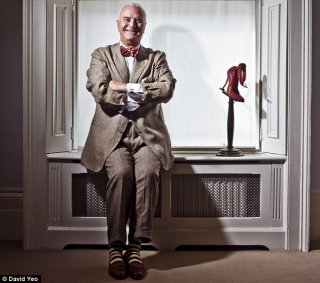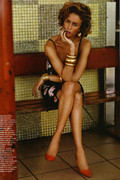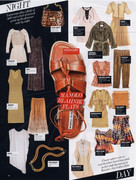You are using an out of date browser. It may not display this or other websites correctly.
You should upgrade or use an alternative browser.
You should upgrade or use an alternative browser.
Manolo Blahnik #2
- Thread starter leyla m.
- Start date
What about these then, they are pretty good, when compared to the sketch.
I disagree, the heel is higher and the arch more curved in the sketch.
Second, the sketch and the final product can't be 100% identical, shoes especially (and other clothes).
Why not?
tigerrouge
Well-Known Member
- Joined
- Feb 25, 2005
- Messages
- 18,919
- Reaction score
- 9,802
Manolo in the You supplement to the Mail on Sunday (dailymail.co.uk

'A mistake made my career': The rise and rise of Manolo Blahnik
After 25,000 perfect pairs, legendary designer Manolo Blahnik tells Lydia Slater why his love affair with women’s shoes will never end
Manolo Blahnik is the world’s greatest shoe designer. His exquisitely crafted confections have graced the feet of the world’s most stylish women, from film stars to princesses, models and stateswomen – and secretaries who’ve saved up for months to afford them.
Jackie Onassis wore Manolos; Madonna said his shoes were ‘as good as sex, and they last longer’. Princess Diana used to sit on the floor of his studio, chatting to him while she tried on pair after pair. ‘I feel honoured that I will be able to tell my grandchildren, “I met Manolo Blahnik, and I owned some of his shoes”,’ said Sarah Jessica Parker, whose role in Sex and the City introduced his creations to a new generation of women. (It has been said
that Blahnik’s shoes were the fifth character in the show.)
You could argue that Blahnik is directly responsible for modern women’s obsession with footwear. ‘He took shoes to a whole new level,’ says fellow designer Patrick Cox. ‘He led directly to Louboutin and Jimmy Choo. Everyone is snapping at his heels – but we’re all kids compared to him. Manolo Blahnik is an artist.’
Indeed, the Blahnik name has become so iconic, it comes as a slight shock that the creative genius behind it is still very much alive. In fact, at 67, he is busier than ever.
A book filled with some of his most extravagant designs has just been published, entitled Manolo’s New Shoes. Among the 130 or so beautifully detailed sketches and lavish illustrations are shoes inspired by influences from horse riding and marine life to Marie Antoinette. The book’s publication coincides with a pop-up ‘World of Manolo’ boutique in Liberty of London, which will sell not only his shoes, but also his bow ties, umbrellas, notebooks, cushions and silk scarves decorated with prints of his designs, and drawings from his shoe archive.
‘It is daunting for me,’ admits Blahnik, who says he hasn’t slept as he’s been worrying so much. ‘I’ve refused so many incredible offers over the years, but this time I decided to see if I was able to cope with the pressure. And before I drop, I would like to sell for a little time in a different store. I’m terrified, but it’s very exciting.’
We have met in the bijou King’s Road townhouse which acts as his office, staffed by willowy young women in vertiginous heels. Blahnik cuts an old-fashioned figure in a loosely cut tweed suit, spotless white shirt and floppy bow tie. His white hair is swept back uncompromisingly off his face. His feet are encased in dainty tan leather and grosgrain pumps.
‘I really don’t like men’s shoes,’ he says dismissively in his unplaceable accent, a swooping melange of Spanish, aristocratic English and Upper East Side. ‘I have these in millions of colours, such as pink and orange. I like that.’ A large bandage is tied around his right ankle. ‘I tore ligaments and a tendon in my foot this year,’ he explains. ‘It’s a nuisance because at the factory I used to try on certain shoes to see if they would snap...’
The mind boggles at the image of this impeccable elderly gentleman strutting around in high heels, but this sort of perfectionism is what lies at the root of Blahnik’s success. ‘He’s the only one who still makes his own shoes; he does the first prototype himself, he cuts it, he stitches it, he does his own heels – no one else does that,’ says Cox.
Two pieces from Blahnik’s new collection stand on the table: a black strappy shoe adorned with multicoloured suede triangles, like miniature bunting, and one in butter-soft red leather with a woven ankle-strap. Both sport his new heel, which is asymmetrically curved and organic-looking.
‘I had such fun doing it,’ says Blahnik, caressing the shoe fondly. ‘It’s very tactile, isn’t it? They said, “It won’t be possible to do it in metal, we’ll need a new machine.” I said, “Get me that bloody machine!”’
Manolo Blahnik’s passion for creating shoes seems to have started in his earliest childhood. ‘I had a wonderful fox terrier and I used to tie ribbons around his legs. Anything that moved, I loved to dress it up. It’s always been a compulsion.’ His background is distinctly exotic: his father was an urbane Czechoslovakian from Prague, and his mother hailed from Santa Cruz de la Palma in the Canary Islands. ‘My father was on a boat trip with his parents and they stopped at the island,’ he explains. ‘He saw my mother at the window and she smiled at him. My father was very handsome – blond, blue eyes – my mother had never seen such a man. He came back another year, and another...’
Eventually, they married and had Manolo and his sister Evangelina (who works with him), bringing them up on the island in splendid isolation, on the family’s banana plantation. This quiet existence was punctuated with moments of great glamour, when they travelled to Europe to order clothes from Balenciaga, his mother’s favourite couturier.
The remoteness of the island seems to have fed the young Manolo’s fertile imagination. ‘There was no television, no aeroplanes until 1967, poets living in 17th-century colonial homes – it was paradise,’ he recalls. ‘During the war, my mother had the desire for beautiful shoes but of course you couldn’t get them, so she learned with the help of the island cobbler how to make them. She got herself the implements and made her own shoes out of wonderful woods and leather, whatever came on the boat. My mama was an extraordinary woman; she encouraged anything my sister and I wanted to do.’
Eventually, Blahnik was cast out from this strange Eden to make his way in the real world. His parents had hoped he might be a diplomat, so he was sent to study law at the University of Geneva – but gave up after his first forensic medicine class, when he passed out at the sight of the corpse. ‘The smell of that stuff they put on the bodies!’ he exclaims, wrinkling his nose. ‘And that thing lying there...’
He switched to literature, but spent most of his time sneaking off to the cinema, convinced that he wanted to work in film. Eventually, he gave up on his studies and moved to Paris, where he worked in a boutique and hung out with Paloma Picasso and Anouk Aimée’s daughter Manuella, then followed the tide of fashion to swinging London, where he felt immediately at home. (He was brought up resolutely Anglophile: his mother used to read him Enid Blyton at bedtime, and his father had a library full of Winston Churchill’s speeches.) Initially, Blahnik worked for Joan Burstein at her Kensington boutique Feathers. Then Paloma Picasso suggested he accompany her to New York to show his set designs to the iconic editor-in-chief of US Vogue, Diana Vreeland. Her advice was unexpected: ‘“Oh my dear boy, do accessories”,’ says Blahnik, imitating her gravelly tones. “‘Do shoes, shoes!” I was petrified by her.’
But he took her advice. It was a good time to get into shoe design since, with the advent of the miniskirt, footwear had a new prominence. One of his earliest collections was for designer Ossie Clark. ‘There was a show at the Royal Court Theatre, and I did the shoes in strict, shocking colours – electric blue with red and white – but I didn’t have much experience and I didn’t know to put steel rods in the heels. So all the beautiful girls, Twiggy and [Salvador Dali’s muse] Amanda Lear, were sort of dancing down the catwalk,’ he goes on, leaping to his feet to demonstrate their undulations, but wincing as he jars his bad ankle.
‘I thought, “Oh my God, it’s the end!” but they loved it. They said “It’s the New Walk!” A mistake made my career.’ Even now, thousands of shoes later, his favourite pair remains one he designed for Clark, which had vines winding up the leg and cherries dangling off it. Blahnik’s first shop, a tiny boutique on Old Church Street in Chelsea, opened in 1973. Since then, he’s designed for everyone from John Galliano to Yves Saint Laurent, carried off scores of awards and allowed himself to be influenced by almost everything he sees around him.
‘I get inspired by flowers, shapes, colours, leaves,’ he says. ‘I went to Bali and thought it would be wonderful to do a collection with coral heels, which was an expensive experience. And I have a shoe that looks like this,’ he says, waving at his desk lamp. ‘It’s got a PVC ribbon running through the aluminium. It’s actually very comfortable.’
Blahnik keeps one of each pair he’s designed: 25,000 shoes are arranged in date order in panelled cupboards that fill up two adjoining houses in a Georgian terrace in Bath. ‘The shoes take up everything,’ he says. ‘My house is not a home any more. It’s Miss Havisham’s house. The first floor has my bed, my films and me, and the kitchen is humid, so I don’t put the shoes down there.’
And still he keeps designing. ‘This is fun,’ he says. ‘You think it’s work? Uh-uh. I have to edit myself or eventually it would be nothing but shoes.’ You do wonder if, in some way, his shoes have become a substitute for meaningful relationships – he is not known to have any significant other, male or female, sharing his life. And although he says he can’t understand shoe fetishism (‘it doesn’t mean anything to me’) the erotic power of his shoes is unmistakeable. His friend, André Leon Talley of US Vogue, says that he ‘captures the most powerful of emotions: desire’. Blahnik admits that he has customers who rush up to him with tears in their eyes, telling him that his shoes have saved their marriage.
‘A good shoe can change your way of walking totally. Immediately. Even a tiny kitten heel, you put it on, you walk differently, you have a cadence, you move your bum. People used to say “Heels give you power”, which I think is a very stupid thing to say,’ he says. ‘But they do give you sex.’ No wonder none of us can resist.
Attachments
Last edited by a moderator:
Tigerrouge, thanks for sharing the article on Manolo. I have to say I just love going into his shop on Church Street, when I know I can afford not to have to resist temptation, it is just just a wonderful shopping experience.
Thanks tigerrouge
I am going to NYC in the beginning of next month. Does anyone know if the Hangisi pumps are still available anywhere? Or what other spectacular shoes are in his current collection? I need something with rhinestones, ruffles or other ornaments!
mateica83
Member
- Joined
- Jul 11, 2005
- Messages
- 612
- Reaction score
- 11
mateica83
Member
- Joined
- Jul 11, 2005
- Messages
- 612
- Reaction score
- 11
Vogue UK February 2011 scanned by gossiping
Vogue US February 2008 scanned by Vogue Girl at bellazon and xPedro
Vogue Latin America July 2010 scanned by kokobombon
Vogue Latin America November 2008 scanned by kokobombon
Vogue US July 2010 scanned by Elfinkova
US Vogue August 1999 source: The Fashion Directory






Vogue US February 2008 scanned by Vogue Girl at bellazon and xPedro
Vogue Latin America July 2010 scanned by kokobombon
Vogue Latin America November 2008 scanned by kokobombon
Vogue US July 2010 scanned by Elfinkova
US Vogue August 1999 source: The Fashion Directory






mateica83
Member
- Joined
- Jul 11, 2005
- Messages
- 612
- Reaction score
- 11
mateica83
Member
- Joined
- Jul 11, 2005
- Messages
- 612
- Reaction score
- 11
Similar Threads
- Replies
- 268
- Views
- 42K
- Replies
- 153
- Views
- 91K
- Locked
- Replies
- 1K
- Views
- 305K
- Replies
- 21
- Views
- 6K
Users who are viewing this thread
Total: 1 (members: 0, guests: 1)


































